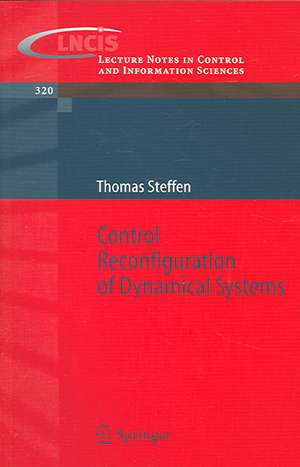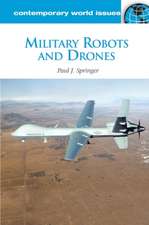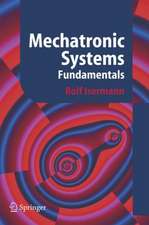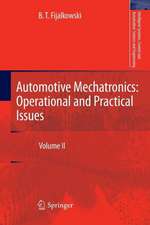Control Reconfiguration of Dynamical Systems: Linear Approaches and Structural Tests: Lecture Notes in Control and Information Sciences, cartea 320
Autor Thomas Steffenen Limba Engleză Paperback – 31 aug 2005
Din seria Lecture Notes in Control and Information Sciences
- 20%
 Preț: 318.80 lei
Preț: 318.80 lei - 15%
 Preț: 628.87 lei
Preț: 628.87 lei - 20%
 Preț: 555.02 lei
Preț: 555.02 lei - 18%
 Preț: 952.92 lei
Preț: 952.92 lei - 15%
 Preț: 690.91 lei
Preț: 690.91 lei - 18%
 Preț: 950.69 lei
Preț: 950.69 lei - 18%
 Preț: 776.66 lei
Preț: 776.66 lei - 18%
 Preț: 887.88 lei
Preț: 887.88 lei - 18%
 Preț: 1103.15 lei
Preț: 1103.15 lei - 20%
 Preț: 344.53 lei
Preț: 344.53 lei - 11%
 Preț: 468.55 lei
Preț: 468.55 lei - 20%
 Preț: 652.32 lei
Preț: 652.32 lei -
 Preț: 384.91 lei
Preț: 384.91 lei -
 Preț: 395.05 lei
Preț: 395.05 lei -
 Preț: 377.08 lei
Preț: 377.08 lei -
 Preț: 391.82 lei
Preț: 391.82 lei -
 Preț: 387.99 lei
Preț: 387.99 lei - 15%
 Preț: 637.78 lei
Preț: 637.78 lei - 15%
 Preț: 643.46 lei
Preț: 643.46 lei -
 Preț: 378.80 lei
Preț: 378.80 lei -
 Preț: 382.81 lei
Preț: 382.81 lei - 15%
 Preț: 636.80 lei
Preț: 636.80 lei - 15%
 Preț: 694.11 lei
Preț: 694.11 lei - 20%
 Preț: 331.29 lei
Preț: 331.29 lei -
 Preț: 376.91 lei
Preț: 376.91 lei -
 Preț: 484.98 lei
Preț: 484.98 lei -
 Preț: 387.78 lei
Preț: 387.78 lei -
 Preț: 420.62 lei
Preț: 420.62 lei -
 Preț: 390.26 lei
Preț: 390.26 lei -
 Preț: 379.55 lei
Preț: 379.55 lei - 18%
 Preț: 731.83 lei
Preț: 731.83 lei -
 Preț: 389.50 lei
Preț: 389.50 lei - 15%
 Preț: 640.53 lei
Preț: 640.53 lei - 15%
 Preț: 633.23 lei
Preț: 633.23 lei -
 Preț: 380.69 lei
Preț: 380.69 lei -
 Preț: 394.68 lei
Preț: 394.68 lei -
 Preț: 404.20 lei
Preț: 404.20 lei -
 Preț: 403.81 lei
Preț: 403.81 lei -
 Preț: 382.25 lei
Preț: 382.25 lei -
 Preț: 384.53 lei
Preț: 384.53 lei -
 Preț: 384.53 lei
Preț: 384.53 lei -
 Preț: 391.82 lei
Preț: 391.82 lei -
 Preț: 388.14 lei
Preț: 388.14 lei -
 Preț: 380.91 lei
Preț: 380.91 lei -
 Preț: 393.72 lei
Preț: 393.72 lei -
 Preț: 380.14 lei
Preț: 380.14 lei -
 Preț: 393.13 lei
Preț: 393.13 lei -
 Preț: 382.25 lei
Preț: 382.25 lei -
 Preț: 381.66 lei
Preț: 381.66 lei -
 Preț: 378.80 lei
Preț: 378.80 lei
Preț: 635.34 lei
Preț vechi: 747.46 lei
-15% Nou
Puncte Express: 953
Preț estimativ în valută:
121.68€ • 125.36$ • 101.93£
121.68€ • 125.36$ • 101.93£
Carte tipărită la comandă
Livrare economică 24 februarie-10 martie
Preluare comenzi: 021 569.72.76
Specificații
ISBN-13: 9783540257301
ISBN-10: 3540257306
Pagini: 270
Ilustrații: XIV, 270 p. 126 illus.
Dimensiuni: 155 x 235 x 20 mm
Greutate: 0.41 kg
Ediția:2005
Editura: Springer Berlin, Heidelberg
Colecția Springer
Seria Lecture Notes in Control and Information Sciences
Locul publicării:Berlin, Heidelberg, Germany
ISBN-10: 3540257306
Pagini: 270
Ilustrații: XIV, 270 p. 126 illus.
Dimensiuni: 155 x 235 x 20 mm
Greutate: 0.41 kg
Ediția:2005
Editura: Springer Berlin, Heidelberg
Colecția Springer
Seria Lecture Notes in Control and Information Sciences
Locul publicării:Berlin, Heidelberg, Germany
Public țintă
ResearchCuprins
Introduction to Control Reconfiguration.- Literature Overview.- Part I. Reconfiguration Problem.- Running Example: the 2-Tank System.- General Reconfiguration Problem.- Part II. Linear Solution Approaches.- Direct Reconfiguration Using a Static Block.- Reconfiguration Using a Virtual Sensor.- Reconfiguration Using a Virtual Actuator.- Reconfiguration with Set-Point Tracking.- Reconfiguration by Disturbance Decoupling.- Part III. Structural Tests for Control Reconfiguration.- Structural Models.- Basic Structural Properties.- Solvability of Disturbance Decoupling.- Structural Solutions to Disturbance Decoupling.- A Structural Reconfiguration Algorithm for Actuator Faults.- Part IV. Application Examples.- Reconfiguration of the 3-Tank System.- Reconfiguration of a Helicopter Model.- Conclusion.
Textul de pe ultima copertă
Fault-tolerant control concerns the operation of the system after a fault has occurred. Unlike the classical control theory, where the behaviour of the system is completely defined, fault-tolerant control has to deal with situations where the system has been damaged. Therefore, the system may not react the way it was designed to.
Reconfiguration is an approach for fault-tolerant control. The idea is to change the control structure in response to the fault. If a sensor signal is lost, the relevant state of the plant has to be observed instead of being measured directly. The book extends this idea to actuator faults: if an actuator gets stuck, another actuator can be used to control the same state, and to close the control loop again. This approach is called {}``virtual actuator'', and it is studied in detail in the first half of the book.
The second half introduces structural analysis as a tool for reconfiguration. Because a fault changes the structure of the system, the reconfiguration solution is sought on a structural level. The system model is abstracted from the specific parameters, and represented by a directed graph. Novel algorithms are presented to test for reconfigurability and to find a reconfiguration solution. A MATLAB toolbox is supplied, which contains the main algorithms and examples.
The book addresses advanced engineering students, developers and researchers that have a specific interest in control reconfiguration. A good understanding of multi-variable dynamic systems is helpful, but the second part is accessible even without this.
Reconfiguration is an approach for fault-tolerant control. The idea is to change the control structure in response to the fault. If a sensor signal is lost, the relevant state of the plant has to be observed instead of being measured directly. The book extends this idea to actuator faults: if an actuator gets stuck, another actuator can be used to control the same state, and to close the control loop again. This approach is called {}``virtual actuator'', and it is studied in detail in the first half of the book.
The second half introduces structural analysis as a tool for reconfiguration. Because a fault changes the structure of the system, the reconfiguration solution is sought on a structural level. The system model is abstracted from the specific parameters, and represented by a directed graph. Novel algorithms are presented to test for reconfigurability and to find a reconfiguration solution. A MATLAB toolbox is supplied, which contains the main algorithms and examples.
The book addresses advanced engineering students, developers and researchers that have a specific interest in control reconfiguration. A good understanding of multi-variable dynamic systems is helpful, but the second part is accessible even without this.
Caracteristici
Comprehensive overview of structural analysis Includes important applications for researchers and practitioners in fault-tolerant control or automation Novel approaches to the control reconfiguration of linear systems Includes supplementary material: sn.pub/extras











